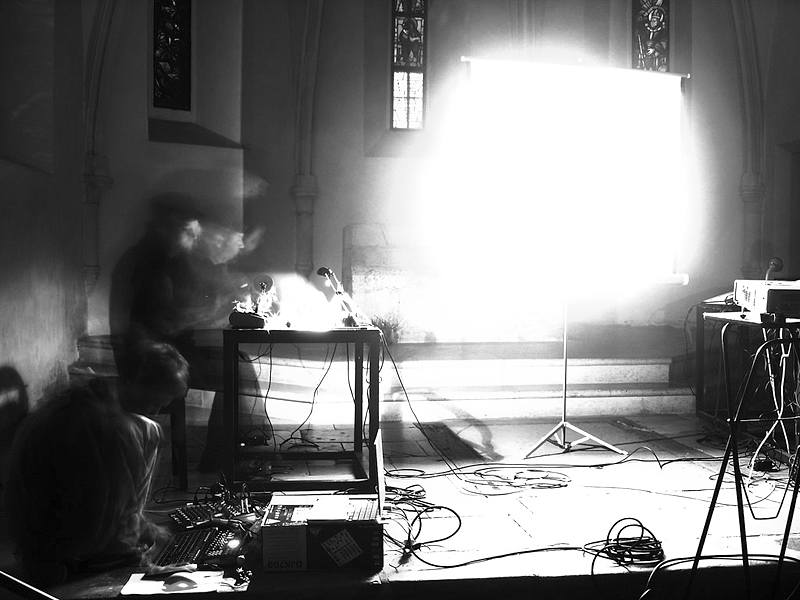4/11 2015, Den otevřených dvěří Ateliéru intermédií FaVU VUT Brno, 13:00–19:00, Údolní 19.
První ateliérová schůzka je ve středu 23/9 13:00, místnost 316 (Údolní). Prosíme o dochvilnost!
Novým vedoucím ateliéru bude od 1. září 2015 umělec Pavel Sterec.
Boy and a distance (interview)
What brings you to film creation? To VJing?
For me it's hard to talk about creation, let alone film, it's more like everyday work with images, and working with moving images in real-time during a concert, which is called for short VJing. Working with film is only a part of what constitutes the creation of my moving images. I love the switch between media and at the crossing to see what each material is in itself.
How long have you been doing it?
VJing about ten years. I did b/w 16mm film projections for the drummer Pavel Fajt at the beginning of his Drum Trek project, which was in the year 1998. With 16mm film, I started in 1992, two years later I borrowed my first video camera and joined the Faculty of Fine Arts in Brno. — Since 1998 I have created, mostly in collaboration with friends of mine, several short films dealing with various languages of (animation) narrativity, a reminiscence to a generation's experience with fairytale creation and experimental use of audial accompaniment.
Is there a central theme around which your films “revolve”?
Limits of the visual environment, clarity, mud, memory, recollection. Visualization of time. Often key words of visuals, from which produced things are compiled, recently are “blank”, “gap”, “eclipse” and “blackout”, a failure of memory as well as of anything else.
Is there something that you are interested in so much that it is constant battle to get to the heart of the matter?
No, I'm not seeking anything specific, things that we are talking about here, are for me “just” an expression of life, I'm almost tempted to say waste (of life), in a true form most of them I just work out in my head, what I finally put out can not present itself, because it is a blend of my world and the world of the other (co-author). The results rarely resemble me, so it's interesting and adventurous for me. For a long time I didn't do anything “myself”, because my experience is that the things I return to most have the shape of someone or something which is not clear to me. This trusting mist around me is necessary. “Boy and a distance” (Chlapeček a dálka).
Do you sometimes overflow with the depressed feeling that what you are doing is completely useless? How do you prevent this?
I don't overflow. I often have the feeling I'm coming to nothing, but not because of something I'm doing. If I don't know where next, if I see the end, I try to take another view. I conceive and remember. For example: I look at the world through the eyes of my expectant daughter. Hope and understanding come immediately: not all who wander are lost.
Are you trying to empathize, with your creation, with the viewers – so they may understand your thing – or do you concentrate purely on your own self-expression?
I don’t do things for the sake of self-expression. At least in the field of images, which are about relations and they are the relation itself. When I need to express myself, I speak. — And in terms of understanding from the audience: I believe that each of us sees what they need to. As it is said: what did you do (as the viewer) to enjoy it? I believe in half-spoken understanding. In friendliness, helpfulness.
Do you have a proven method of obtaining your own inspiration?
Inspiration is something like an stolen view. The rest probably goes without saying... And imagination, this adventure of memory, is what in this view is recognized.
What is your favorite method of animation? 3D, Flash, paper or drawing animation, collage, pixilation... and why?
They are chosen according to needs. The electronic project Midi Lidi needed a fun and playful projection, so during the sound check before the first concert, we selected geometric colorful vector based animations from a friend of mine, although together with Magdalena Hrubá we had prepared a minimalistic black and white animation. The project with musician Ivan Palacký or with other people from the electro-acoustic scene, where you can find more silence than sounds, where you can find naturally accented gaps, required a closer real-time image manipulation in interaction with sound. This insight took me to an old macintosh program Image/ine, which is more appropriate to a synaesthetic performance. — When I turn from Vjing, then a lot of work comes from the methods of classic animation, because we were focused on children’s memory (“thing in which I forgot myself”) and gradually with friends we went through drawing, screen and puppet animation, including additional post-production 3D effects.
Do you work alone or collaborate with someone?
I haven’t seen anyone who works alone for a long time.
How do you present your work?
According to the context... galleries, cinemas, concerts in clubs... “quiet” (chinese) post.
— Filip Cenek aka VJ Věra Lukášová, interview by O. Sevick, photo by A. Castello (St. Ruprecht, Vienna), February 2008.
■
http://intermedia.ffa.vutbr.cz/carpets-curtains
